Analysis of Soft Skills and Hospitality: MCAST Assignment 3
VerifiedAdded on 2022/09/09
|8
|1714
|15
Homework Assignment
AI Summary
This assignment analyzes soft skills within the hospitality industry, addressing communication styles (passive, aggressive, assertive) in various scenarios such as requesting to leave work early and handling incorrect orders. It differentiates between win-win and win-lose situations, emphasizing the importance of the former for positive outcomes and employee relations. The assignment further evaluates the characteristics of a responsible receptionist, highlighting skills and behaviors crucial for front desk roles. It then delves into the significance of customer service, outlining six key steps for effective customer service training, and provides a personal approach to resolving a customer service issue. Finally, it explores the five stages of communication, identifies communication barriers in the hospitality industry, and suggests solutions to overcome these challenges. The assignment also includes references from various authors and journals.
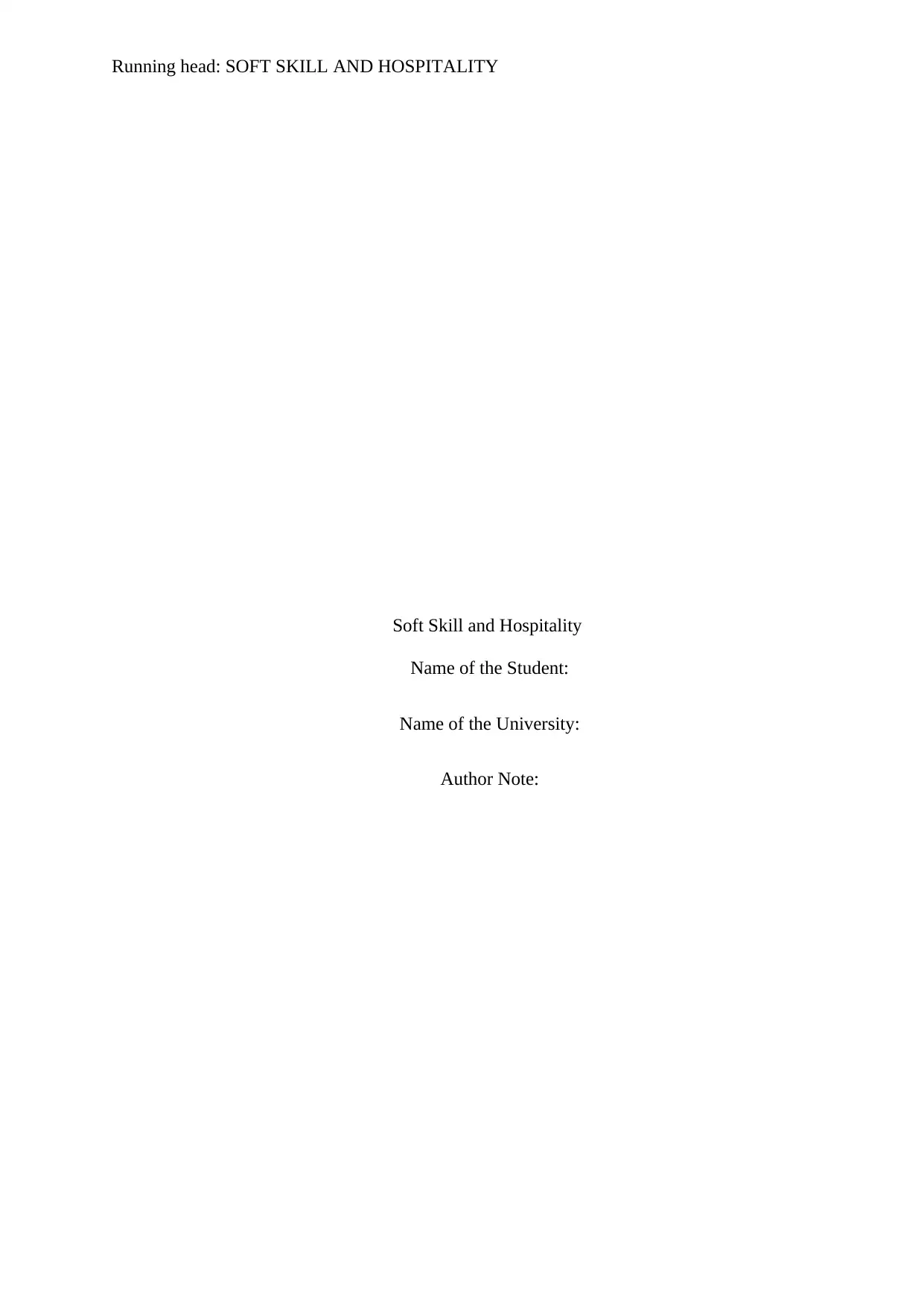
Running head: SOFT SKILL AND HOSPITALITY
Soft Skill and Hospitality
Name of the Student:
Name of the University:
Author Note:
Soft Skill and Hospitality
Name of the Student:
Name of the University:
Author Note:
Paraphrase This Document
Need a fresh take? Get an instant paraphrase of this document with our AI Paraphraser
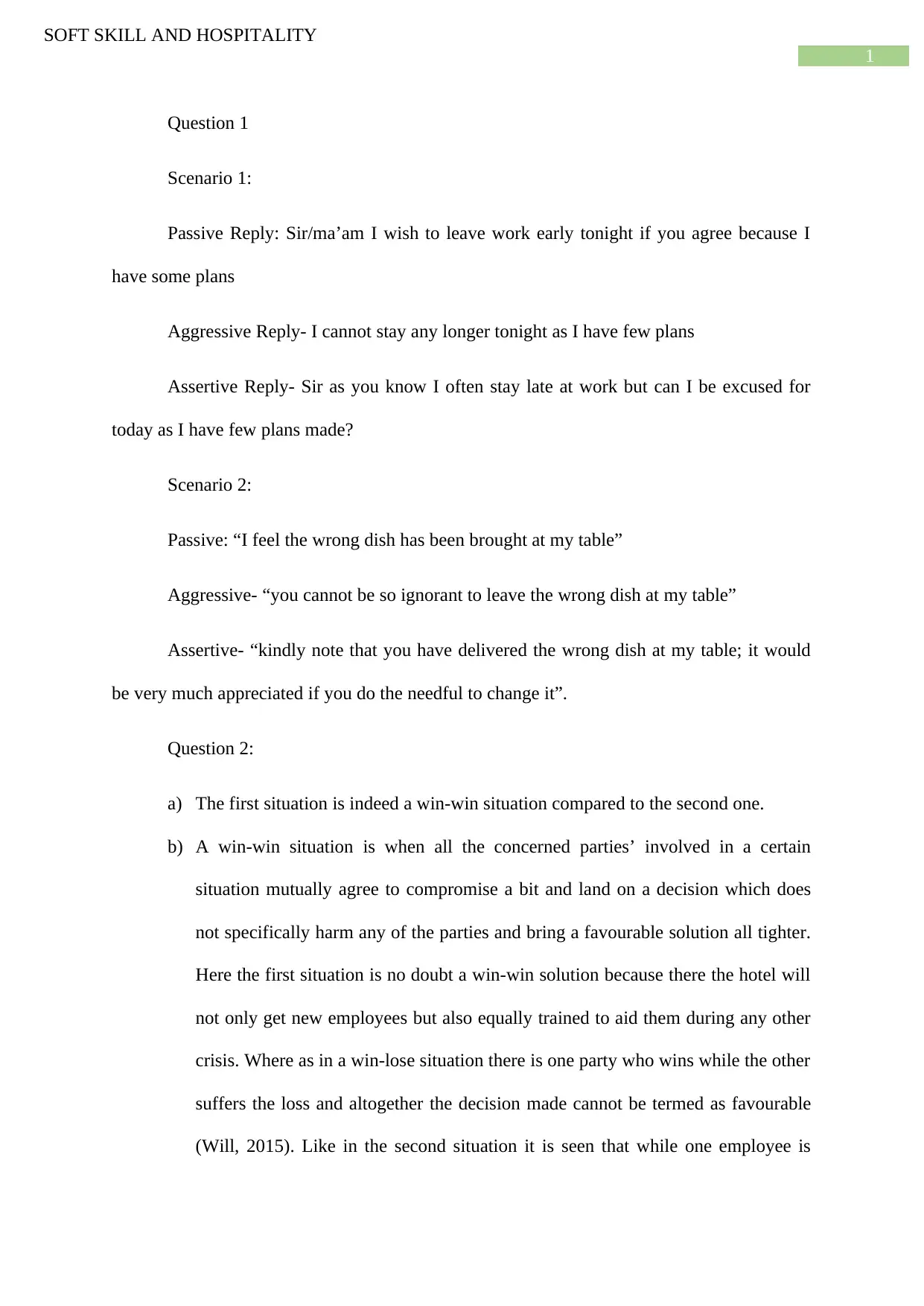
1
SOFT SKILL AND HOSPITALITY
Question 1
Scenario 1:
Passive Reply: Sir/ma’am I wish to leave work early tonight if you agree because I
have some plans
Aggressive Reply- I cannot stay any longer tonight as I have few plans
Assertive Reply- Sir as you know I often stay late at work but can I be excused for
today as I have few plans made?
Scenario 2:
Passive: “I feel the wrong dish has been brought at my table”
Aggressive- “you cannot be so ignorant to leave the wrong dish at my table”
Assertive- “kindly note that you have delivered the wrong dish at my table; it would
be very much appreciated if you do the needful to change it”.
Question 2:
a) The first situation is indeed a win-win situation compared to the second one.
b) A win-win situation is when all the concerned parties’ involved in a certain
situation mutually agree to compromise a bit and land on a decision which does
not specifically harm any of the parties and bring a favourable solution all tighter.
Here the first situation is no doubt a win-win solution because there the hotel will
not only get new employees but also equally trained to aid them during any other
crisis. Where as in a win-lose situation there is one party who wins while the other
suffers the loss and altogether the decision made cannot be termed as favourable
(Will, 2015). Like in the second situation it is seen that while one employee is
SOFT SKILL AND HOSPITALITY
Question 1
Scenario 1:
Passive Reply: Sir/ma’am I wish to leave work early tonight if you agree because I
have some plans
Aggressive Reply- I cannot stay any longer tonight as I have few plans
Assertive Reply- Sir as you know I often stay late at work but can I be excused for
today as I have few plans made?
Scenario 2:
Passive: “I feel the wrong dish has been brought at my table”
Aggressive- “you cannot be so ignorant to leave the wrong dish at my table”
Assertive- “kindly note that you have delivered the wrong dish at my table; it would
be very much appreciated if you do the needful to change it”.
Question 2:
a) The first situation is indeed a win-win situation compared to the second one.
b) A win-win situation is when all the concerned parties’ involved in a certain
situation mutually agree to compromise a bit and land on a decision which does
not specifically harm any of the parties and bring a favourable solution all tighter.
Here the first situation is no doubt a win-win solution because there the hotel will
not only get new employees but also equally trained to aid them during any other
crisis. Where as in a win-lose situation there is one party who wins while the other
suffers the loss and altogether the decision made cannot be termed as favourable
(Will, 2015). Like in the second situation it is seen that while one employee is
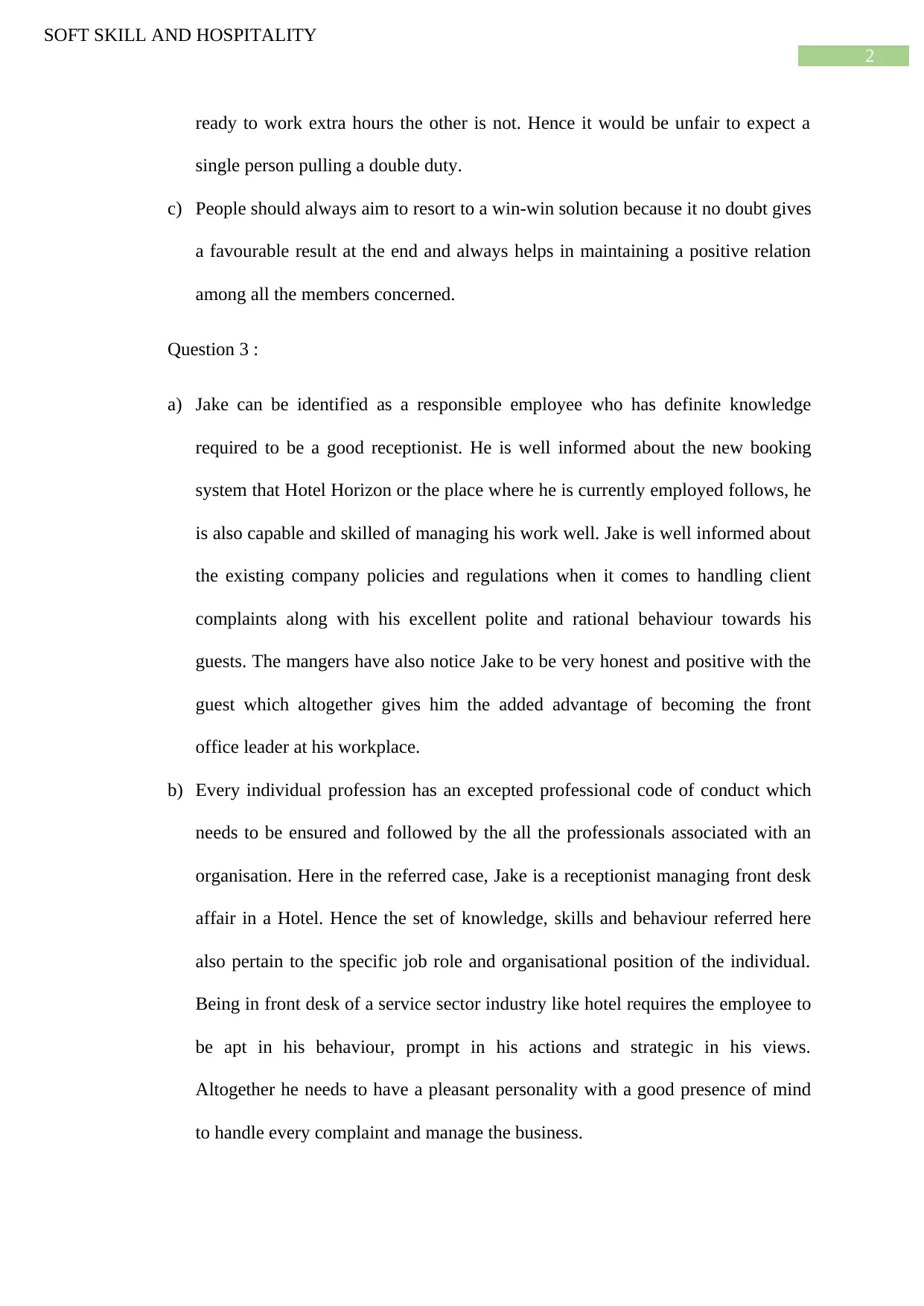
2
SOFT SKILL AND HOSPITALITY
ready to work extra hours the other is not. Hence it would be unfair to expect a
single person pulling a double duty.
c) People should always aim to resort to a win-win solution because it no doubt gives
a favourable result at the end and always helps in maintaining a positive relation
among all the members concerned.
Question 3 :
a) Jake can be identified as a responsible employee who has definite knowledge
required to be a good receptionist. He is well informed about the new booking
system that Hotel Horizon or the place where he is currently employed follows, he
is also capable and skilled of managing his work well. Jake is well informed about
the existing company policies and regulations when it comes to handling client
complaints along with his excellent polite and rational behaviour towards his
guests. The mangers have also notice Jake to be very honest and positive with the
guest which altogether gives him the added advantage of becoming the front
office leader at his workplace.
b) Every individual profession has an excepted professional code of conduct which
needs to be ensured and followed by the all the professionals associated with an
organisation. Here in the referred case, Jake is a receptionist managing front desk
affair in a Hotel. Hence the set of knowledge, skills and behaviour referred here
also pertain to the specific job role and organisational position of the individual.
Being in front desk of a service sector industry like hotel requires the employee to
be apt in his behaviour, prompt in his actions and strategic in his views.
Altogether he needs to have a pleasant personality with a good presence of mind
to handle every complaint and manage the business.
SOFT SKILL AND HOSPITALITY
ready to work extra hours the other is not. Hence it would be unfair to expect a
single person pulling a double duty.
c) People should always aim to resort to a win-win solution because it no doubt gives
a favourable result at the end and always helps in maintaining a positive relation
among all the members concerned.
Question 3 :
a) Jake can be identified as a responsible employee who has definite knowledge
required to be a good receptionist. He is well informed about the new booking
system that Hotel Horizon or the place where he is currently employed follows, he
is also capable and skilled of managing his work well. Jake is well informed about
the existing company policies and regulations when it comes to handling client
complaints along with his excellent polite and rational behaviour towards his
guests. The mangers have also notice Jake to be very honest and positive with the
guest which altogether gives him the added advantage of becoming the front
office leader at his workplace.
b) Every individual profession has an excepted professional code of conduct which
needs to be ensured and followed by the all the professionals associated with an
organisation. Here in the referred case, Jake is a receptionist managing front desk
affair in a Hotel. Hence the set of knowledge, skills and behaviour referred here
also pertain to the specific job role and organisational position of the individual.
Being in front desk of a service sector industry like hotel requires the employee to
be apt in his behaviour, prompt in his actions and strategic in his views.
Altogether he needs to have a pleasant personality with a good presence of mind
to handle every complaint and manage the business.
⊘ This is a preview!⊘
Do you want full access?
Subscribe today to unlock all pages.

Trusted by 1+ million students worldwide
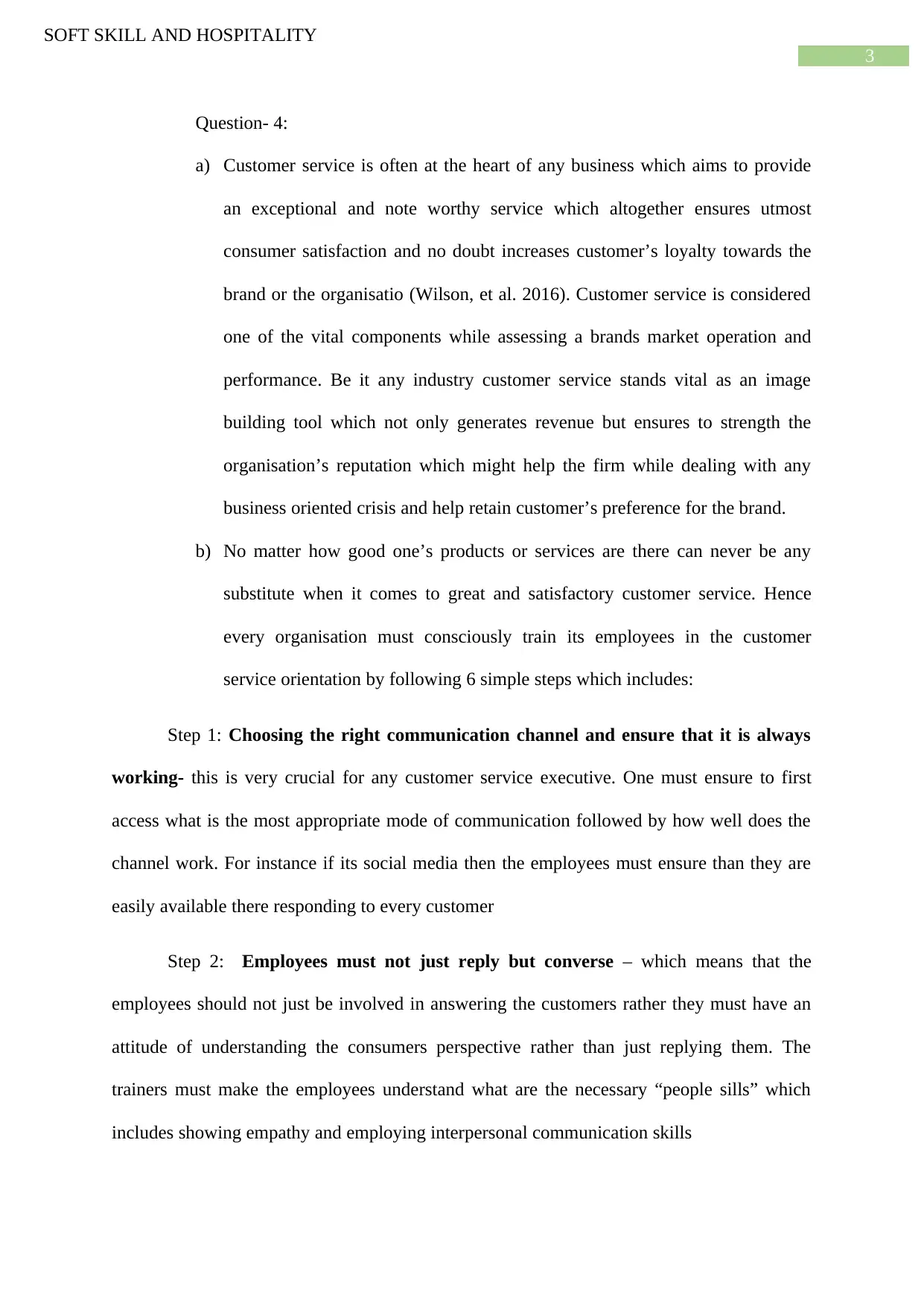
3
SOFT SKILL AND HOSPITALITY
Question- 4:
a) Customer service is often at the heart of any business which aims to provide
an exceptional and note worthy service which altogether ensures utmost
consumer satisfaction and no doubt increases customer’s loyalty towards the
brand or the organisatio (Wilson, et al. 2016). Customer service is considered
one of the vital components while assessing a brands market operation and
performance. Be it any industry customer service stands vital as an image
building tool which not only generates revenue but ensures to strength the
organisation’s reputation which might help the firm while dealing with any
business oriented crisis and help retain customer’s preference for the brand.
b) No matter how good one’s products or services are there can never be any
substitute when it comes to great and satisfactory customer service. Hence
every organisation must consciously train its employees in the customer
service orientation by following 6 simple steps which includes:
Step 1: Choosing the right communication channel and ensure that it is always
working- this is very crucial for any customer service executive. One must ensure to first
access what is the most appropriate mode of communication followed by how well does the
channel work. For instance if its social media then the employees must ensure than they are
easily available there responding to every customer
Step 2: Employees must not just reply but converse – which means that the
employees should not just be involved in answering the customers rather they must have an
attitude of understanding the consumers perspective rather than just replying them. The
trainers must make the employees understand what are the necessary “people sills” which
includes showing empathy and employing interpersonal communication skills
SOFT SKILL AND HOSPITALITY
Question- 4:
a) Customer service is often at the heart of any business which aims to provide
an exceptional and note worthy service which altogether ensures utmost
consumer satisfaction and no doubt increases customer’s loyalty towards the
brand or the organisatio (Wilson, et al. 2016). Customer service is considered
one of the vital components while assessing a brands market operation and
performance. Be it any industry customer service stands vital as an image
building tool which not only generates revenue but ensures to strength the
organisation’s reputation which might help the firm while dealing with any
business oriented crisis and help retain customer’s preference for the brand.
b) No matter how good one’s products or services are there can never be any
substitute when it comes to great and satisfactory customer service. Hence
every organisation must consciously train its employees in the customer
service orientation by following 6 simple steps which includes:
Step 1: Choosing the right communication channel and ensure that it is always
working- this is very crucial for any customer service executive. One must ensure to first
access what is the most appropriate mode of communication followed by how well does the
channel work. For instance if its social media then the employees must ensure than they are
easily available there responding to every customer
Step 2: Employees must not just reply but converse – which means that the
employees should not just be involved in answering the customers rather they must have an
attitude of understanding the consumers perspective rather than just replying them. The
trainers must make the employees understand what are the necessary “people sills” which
includes showing empathy and employing interpersonal communication skills
Paraphrase This Document
Need a fresh take? Get an instant paraphrase of this document with our AI Paraphraser
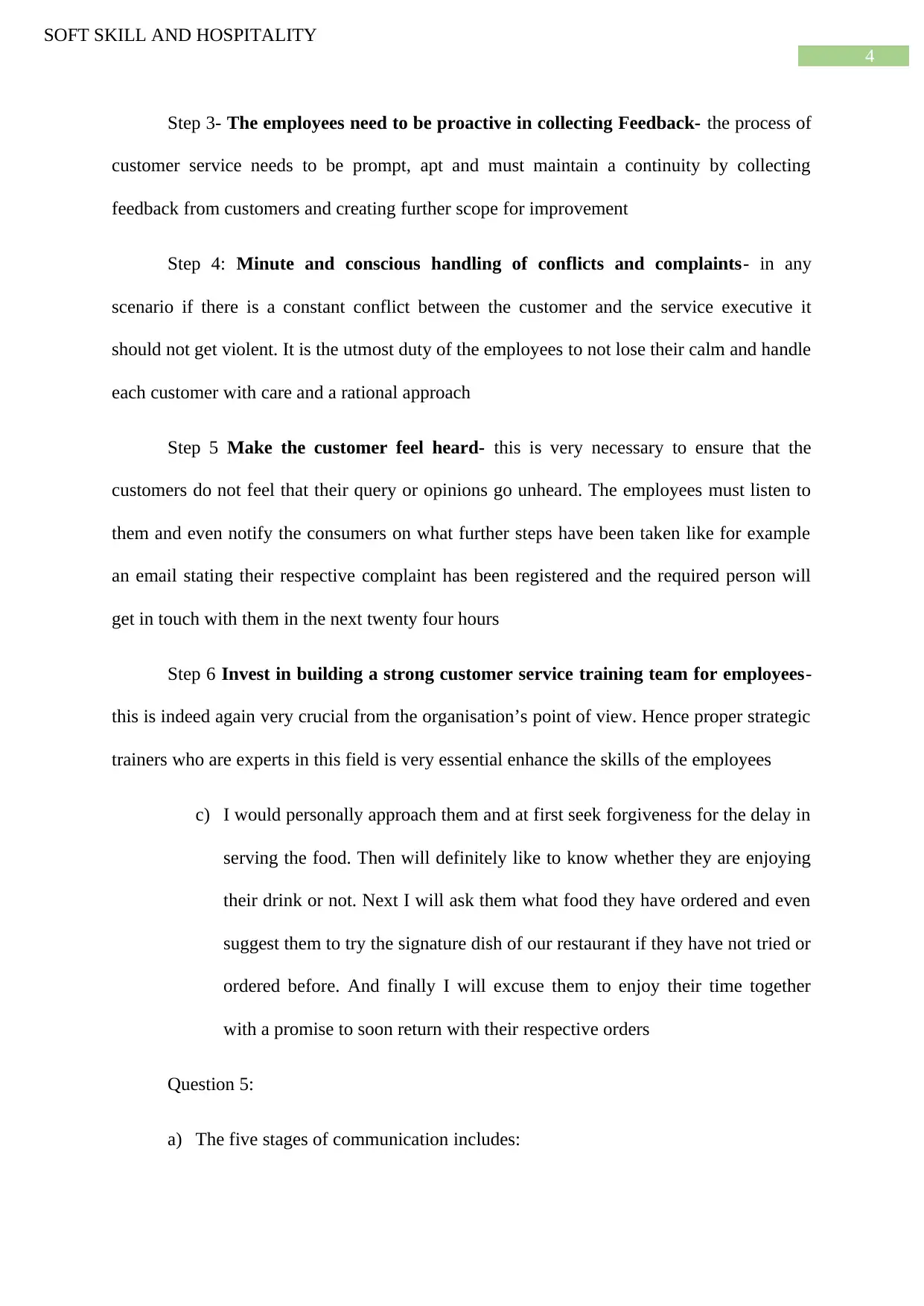
4
SOFT SKILL AND HOSPITALITY
Step 3- The employees need to be proactive in collecting Feedback- the process of
customer service needs to be prompt, apt and must maintain a continuity by collecting
feedback from customers and creating further scope for improvement
Step 4: Minute and conscious handling of conflicts and complaints- in any
scenario if there is a constant conflict between the customer and the service executive it
should not get violent. It is the utmost duty of the employees to not lose their calm and handle
each customer with care and a rational approach
Step 5 Make the customer feel heard- this is very necessary to ensure that the
customers do not feel that their query or opinions go unheard. The employees must listen to
them and even notify the consumers on what further steps have been taken like for example
an email stating their respective complaint has been registered and the required person will
get in touch with them in the next twenty four hours
Step 6 Invest in building a strong customer service training team for employees-
this is indeed again very crucial from the organisation’s point of view. Hence proper strategic
trainers who are experts in this field is very essential enhance the skills of the employees
c) I would personally approach them and at first seek forgiveness for the delay in
serving the food. Then will definitely like to know whether they are enjoying
their drink or not. Next I will ask them what food they have ordered and even
suggest them to try the signature dish of our restaurant if they have not tried or
ordered before. And finally I will excuse them to enjoy their time together
with a promise to soon return with their respective orders
Question 5:
a) The five stages of communication includes:
SOFT SKILL AND HOSPITALITY
Step 3- The employees need to be proactive in collecting Feedback- the process of
customer service needs to be prompt, apt and must maintain a continuity by collecting
feedback from customers and creating further scope for improvement
Step 4: Minute and conscious handling of conflicts and complaints- in any
scenario if there is a constant conflict between the customer and the service executive it
should not get violent. It is the utmost duty of the employees to not lose their calm and handle
each customer with care and a rational approach
Step 5 Make the customer feel heard- this is very necessary to ensure that the
customers do not feel that their query or opinions go unheard. The employees must listen to
them and even notify the consumers on what further steps have been taken like for example
an email stating their respective complaint has been registered and the required person will
get in touch with them in the next twenty four hours
Step 6 Invest in building a strong customer service training team for employees-
this is indeed again very crucial from the organisation’s point of view. Hence proper strategic
trainers who are experts in this field is very essential enhance the skills of the employees
c) I would personally approach them and at first seek forgiveness for the delay in
serving the food. Then will definitely like to know whether they are enjoying
their drink or not. Next I will ask them what food they have ordered and even
suggest them to try the signature dish of our restaurant if they have not tried or
ordered before. And finally I will excuse them to enjoy their time together
with a promise to soon return with their respective orders
Question 5:
a) The five stages of communication includes:
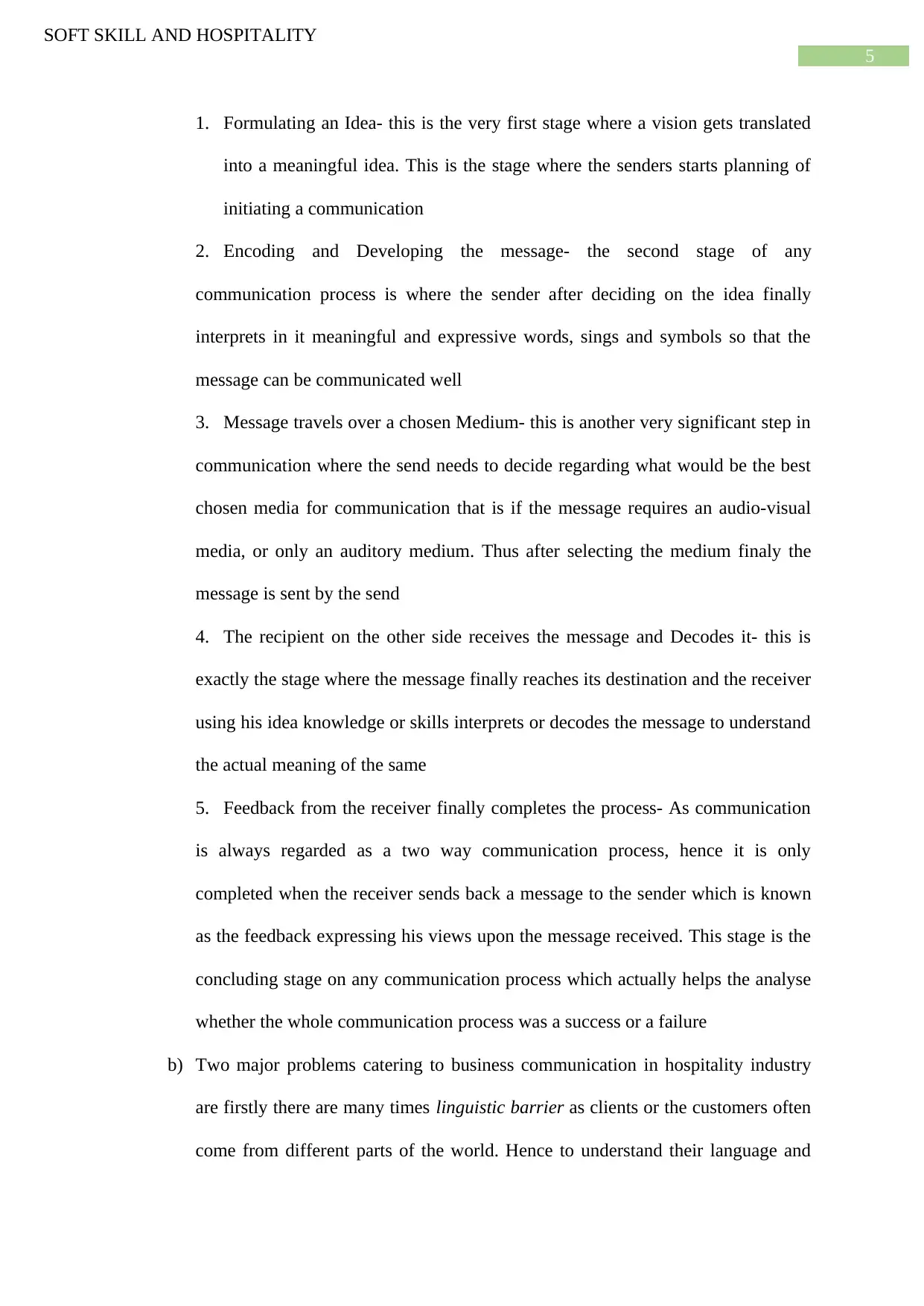
5
SOFT SKILL AND HOSPITALITY
1. Formulating an Idea- this is the very first stage where a vision gets translated
into a meaningful idea. This is the stage where the senders starts planning of
initiating a communication
2. Encoding and Developing the message- the second stage of any
communication process is where the sender after deciding on the idea finally
interprets in it meaningful and expressive words, sings and symbols so that the
message can be communicated well
3. Message travels over a chosen Medium- this is another very significant step in
communication where the send needs to decide regarding what would be the best
chosen media for communication that is if the message requires an audio-visual
media, or only an auditory medium. Thus after selecting the medium finaly the
message is sent by the send
4. The recipient on the other side receives the message and Decodes it- this is
exactly the stage where the message finally reaches its destination and the receiver
using his idea knowledge or skills interprets or decodes the message to understand
the actual meaning of the same
5. Feedback from the receiver finally completes the process- As communication
is always regarded as a two way communication process, hence it is only
completed when the receiver sends back a message to the sender which is known
as the feedback expressing his views upon the message received. This stage is the
concluding stage on any communication process which actually helps the analyse
whether the whole communication process was a success or a failure
b) Two major problems catering to business communication in hospitality industry
are firstly there are many times linguistic barrier as clients or the customers often
come from different parts of the world. Hence to understand their language and
SOFT SKILL AND HOSPITALITY
1. Formulating an Idea- this is the very first stage where a vision gets translated
into a meaningful idea. This is the stage where the senders starts planning of
initiating a communication
2. Encoding and Developing the message- the second stage of any
communication process is where the sender after deciding on the idea finally
interprets in it meaningful and expressive words, sings and symbols so that the
message can be communicated well
3. Message travels over a chosen Medium- this is another very significant step in
communication where the send needs to decide regarding what would be the best
chosen media for communication that is if the message requires an audio-visual
media, or only an auditory medium. Thus after selecting the medium finaly the
message is sent by the send
4. The recipient on the other side receives the message and Decodes it- this is
exactly the stage where the message finally reaches its destination and the receiver
using his idea knowledge or skills interprets or decodes the message to understand
the actual meaning of the same
5. Feedback from the receiver finally completes the process- As communication
is always regarded as a two way communication process, hence it is only
completed when the receiver sends back a message to the sender which is known
as the feedback expressing his views upon the message received. This stage is the
concluding stage on any communication process which actually helps the analyse
whether the whole communication process was a success or a failure
b) Two major problems catering to business communication in hospitality industry
are firstly there are many times linguistic barrier as clients or the customers often
come from different parts of the world. Hence to understand their language and
⊘ This is a preview!⊘
Do you want full access?
Subscribe today to unlock all pages.

Trusted by 1+ million students worldwide
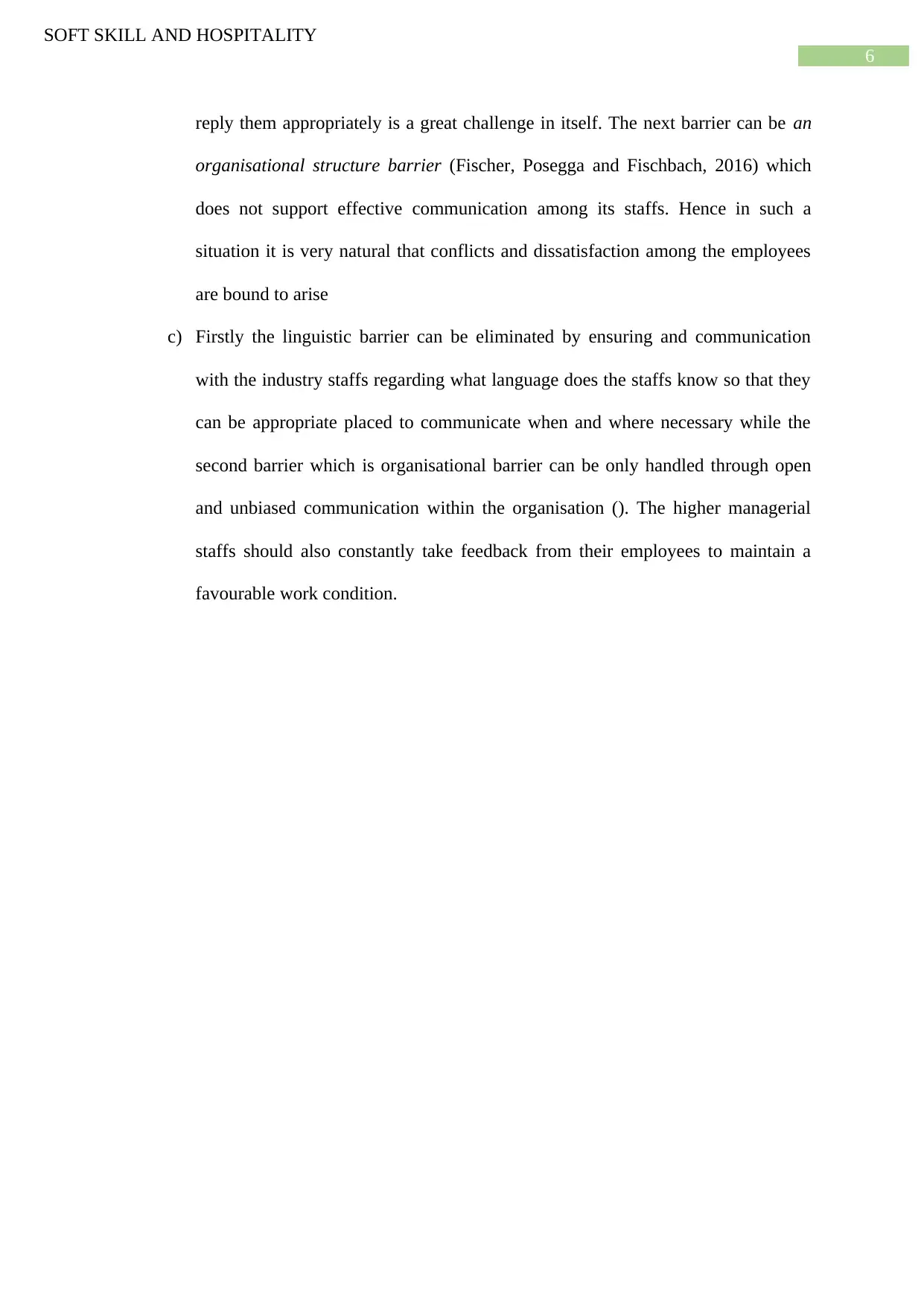
6
SOFT SKILL AND HOSPITALITY
reply them appropriately is a great challenge in itself. The next barrier can be an
organisational structure barrier (Fischer, Posegga and Fischbach, 2016) which
does not support effective communication among its staffs. Hence in such a
situation it is very natural that conflicts and dissatisfaction among the employees
are bound to arise
c) Firstly the linguistic barrier can be eliminated by ensuring and communication
with the industry staffs regarding what language does the staffs know so that they
can be appropriate placed to communicate when and where necessary while the
second barrier which is organisational barrier can be only handled through open
and unbiased communication within the organisation (). The higher managerial
staffs should also constantly take feedback from their employees to maintain a
favourable work condition.
SOFT SKILL AND HOSPITALITY
reply them appropriately is a great challenge in itself. The next barrier can be an
organisational structure barrier (Fischer, Posegga and Fischbach, 2016) which
does not support effective communication among its staffs. Hence in such a
situation it is very natural that conflicts and dissatisfaction among the employees
are bound to arise
c) Firstly the linguistic barrier can be eliminated by ensuring and communication
with the industry staffs regarding what language does the staffs know so that they
can be appropriate placed to communicate when and where necessary while the
second barrier which is organisational barrier can be only handled through open
and unbiased communication within the organisation (). The higher managerial
staffs should also constantly take feedback from their employees to maintain a
favourable work condition.
Paraphrase This Document
Need a fresh take? Get an instant paraphrase of this document with our AI Paraphraser
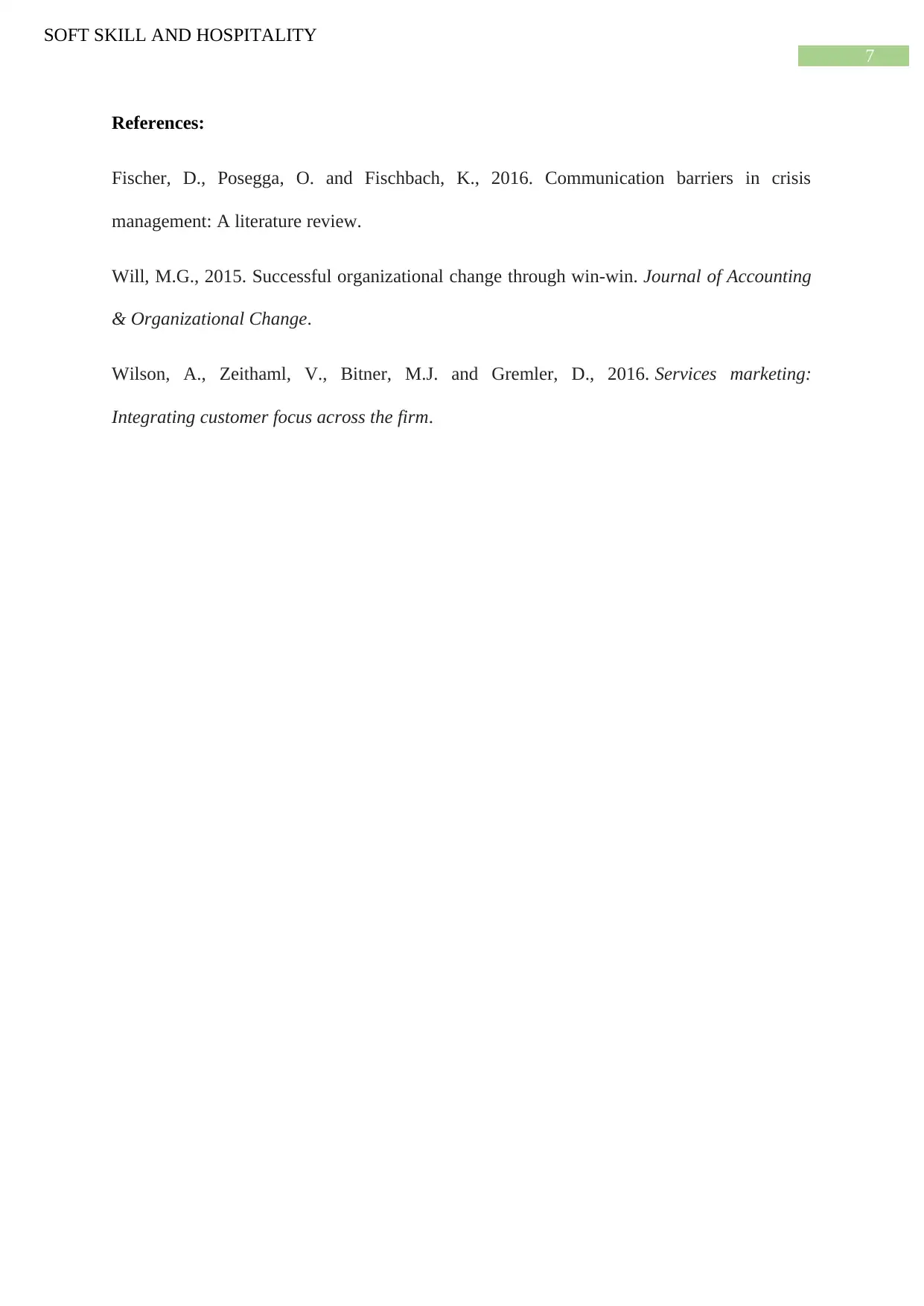
7
SOFT SKILL AND HOSPITALITY
References:
Fischer, D., Posegga, O. and Fischbach, K., 2016. Communication barriers in crisis
management: A literature review.
Will, M.G., 2015. Successful organizational change through win-win. Journal of Accounting
& Organizational Change.
Wilson, A., Zeithaml, V., Bitner, M.J. and Gremler, D., 2016. Services marketing:
Integrating customer focus across the firm.
SOFT SKILL AND HOSPITALITY
References:
Fischer, D., Posegga, O. and Fischbach, K., 2016. Communication barriers in crisis
management: A literature review.
Will, M.G., 2015. Successful organizational change through win-win. Journal of Accounting
& Organizational Change.
Wilson, A., Zeithaml, V., Bitner, M.J. and Gremler, D., 2016. Services marketing:
Integrating customer focus across the firm.
1 out of 8
Your All-in-One AI-Powered Toolkit for Academic Success.
+13062052269
info@desklib.com
Available 24*7 on WhatsApp / Email
![[object Object]](/_next/static/media/star-bottom.7253800d.svg)
Unlock your academic potential
Copyright © 2020–2025 A2Z Services. All Rights Reserved. Developed and managed by ZUCOL.

